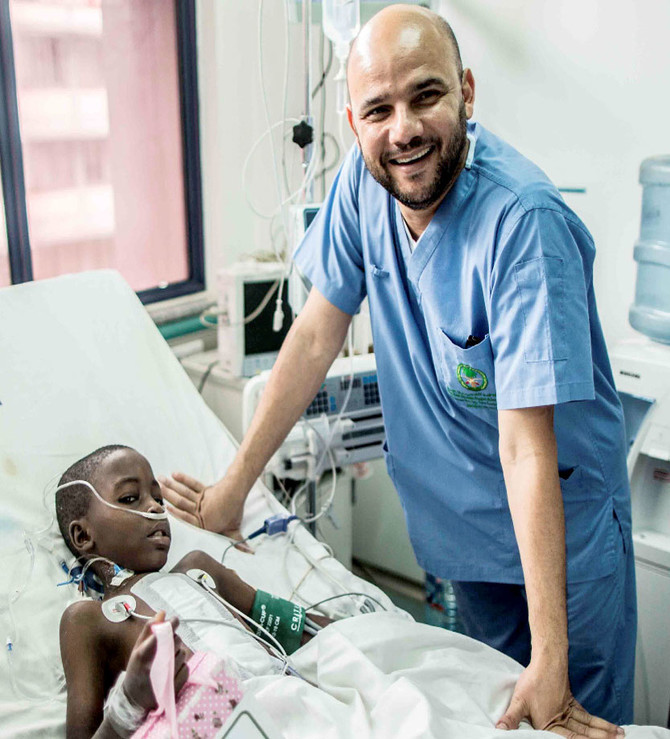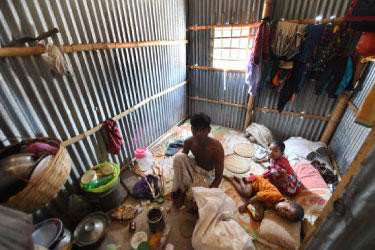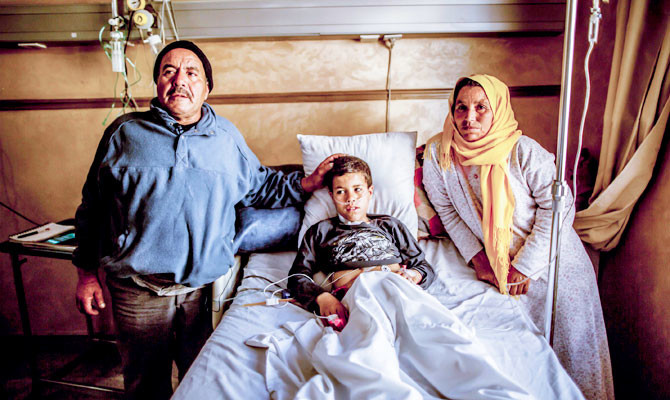SWITZERLAND: It’s a simple gesture, but it can help to break a world record — and mend hearts. Little Hearts is a project that gives impoverished children with congenital heart disease (CHD) access to life-saving treatment, thanks in large part to philanthropists from Saudi Arabia. To continue doing its good work, it is aiming to gain international recognition by launching a Guinness World Record attempt to create the largest-ever online photo gallery. Little Hearts is asking people across the globe to submit a picture of themselves making a hand-to-heart gesture to raise awareness of CHD — caused by a problem in the structure of the heart — and vital funds toward the projects’ goals.
“The Guinness World record itself is to get 60,000 photos of individuals making the heart gesture, which just fits perfectly with the campaign, as every heart deserves to beat,” said Reza Malik, fund-raising officer for Little Hearts. “We want to set ourselves a target of a year.”
The Little Hearts project provides free life-saving cardiac surgery and interventional cardiac catheterization for children with congenital heart defects from underprivileged families irrespective of gender, race or religion.
Each year more than a million babies worldwide are born with CHD; 100,000 of them will not live to see their first birthday and thousands more will die before they reach adulthood. “The majority of these who do survive beyond the first year of life will live in pain unless they live in the developed world where they have access to health systems,” Malik said. “That is why our ultimate aim is to provide life-saving heart operations to babies born with congenital heart defects in the Third World.
“We have a criteria: Their families are impoverished. There is no chance they can afford the medical operation and treatment required to help these children survive. Congenital heart defects are treatable. We have the solution for it; the issue is that it costs a lot of money.”
A standard CHD operation costs more than SR7,000 ($1,800) per child. “But that is a direct deliverable,” Malik said. “You are instantly saving a life.”
Little Hearts is the flagship project of the global humanitarian charity Muntada Aid, which operates in some of the world’s most vulnerable places, providing assistance to communities affected by disasters, conflicts and poverty.
The organization’s core values are faith-inspired by the Islamic tenets of integrity, transparency, the uplifting of the needy, safeguarding the vulnerable and having a sustainable impact on the world. It was initiated from Saudi Arabia in the form of a trust.
In the past seven years, the Little Hearts project has conducted 27 successful week-long missions, which involve sending an expert team of 30 — including heart surgeons, pediatricians, anesthesiologists and nurses — to developing countries such as Bangladesh, Sudan, Mauritania, Yemen and Tanzania. The teams have performed dozens of free surgeries. At times many of these countries have not had a single heart surgeon who can perform open-heart surgery on babies and small children. The cause of a congenital heart defect — signs and symptoms of which can include rapid breathing, bluish skin, poor weight gain and feeling tired — is often unknown. However, it can be caused by infections during pregnancy such as rubella, the use of certain medications or drugs such as alcohol or tobacco, parents being closely related and poor nutritional status or obesity in the mother. Serious congenital heart defects usually become evident soon after birth or during the first few months of life.
“It (the Little Hearts project) has a 97-per-cent success rate, so it is promising,” Malik explained. “The risk-to-reward ratio is extremely high. But is is not just about saving a life, but about giving the quality of life back to a child that is their basic human right. These babies are often underdeveloped; they cannot run or play like their peers.
“They have a right to their childhood and a right to life itself. By saving a single baby’s life, potentially you have saved up to nine other members of the immediate family, from parents to siblings. Why? Because usually the parents, the siblings, they are all working for the survival of this baby or child. Their world revolves around them. Usually the siblings are out of education; they are forced to earn a living. The mother’s care goes into the focus of that child. These operations turn tears of grief to tears of joy.”
Since its launch in 2011, Little Hearts has saved the lives of more than 1,800 children. Generous donors, he said, are the heart of the project and allow the team to continue their lifesaving work.
Philanthropists from Saudi Arabia have been the most prolific donors. “Initially a lot of the funding for the project, when it was first initiated, was from philanthropists from the Middle East, primarily Saudi Arabia,” Malik said. “Now we want to take this global. We want to take the Little Hearts mission and the cause of children with congenital heart defects and to turn that into a visible, viable issue and concern for the international community — from the UN to governments themselves. “Because it is not a communicable disease like malaria, there is no governmental or UN agenda to resolve the problem itself — to eradicate the disease and reduce the time it takes to provide treatment to these children.
“We know this is a global epidemic; it is one of the most common diseases of the heart in the world. Yet there is no governmental or UN mandate to reduce the rate, whereas we have the treatment — and we have the solutions.”
Malik said that there are two key goals of the Little Hearts project. “The aim is to continue providing the missions to the communities and countries in developing nations where they need that immediate support, because without it the governments are not going to subsidize the costs related to taking these children in these countries to places where they can get access to the treatment they need,” he said.
“The short-term goal is to continue the mission, but with that is the cost of logistics, bringing those facilities to a country on a temporary basis to be able to carry out these operations and then disbanding and moving on.
“This brings us to our second mission, our long-term goal. In the next three years we want to establish five full-time clinics with trained pediatricians and cardiologists who can perform these operations in these countries such as Egypt, Morocco, Mali, Tanzania and Chad.”
Little Hearts already has a dedicated center in Bangladesh, which has been fully operational for a year. A second center is about to be launched in South Africa.
As well as performing life-saving operations, heart surgeons with Little Hearts also run a training program, equipping local doctors with the knowledge to perform the complex procedures.
The goal over the next three years is to increase the impact of the Little Hearts project by increasing capacity in hospitals and cardiac centers in developing nations to be able to provide an international standard of specialist paediatric cardiac intervention, saving the lives of many more babies in Africa, Asia and the Middle East.
Malik hopes the photo campaign will bring the awareness — and encourage the donation of vital funds — to continue and build on the organization’s life-saving work.
“The campaign has two aims; one to raise awareness of the plight of children suffering with congenital heart disease; secondly to give it that platform and visibility on an international stage and among high-level governments and within the United Nations so we can engage and say these are the solutions, now there needs to be action and finances,” he said.
“You can’t expect the general public to be pooling together these resources, because they are not cheap. We know there is funding for public health care infrastructure. Let’s give it its due. Because those 1.4 million children deserve that.”
Dr. Jamal Al-Ata, head surgeon at Little Hearts, said: “Unfortunately, the treatment of heart disease in the developing world is not given proper attention, due to the lack of financial resources and that of trained medical staff. It is important this is overcome.” His words were echoed by Dr. Mansur Al-Mathari, a consultant pediatric cardiologist with the project. “We need your support,” he said. “We need the support of everyone to keep this program running and hopefully we can save a lot of patients’ lives around the world.” The public can upload their entries for the photo campaign at: http://handstohearts.photos/
Project funded mainly by Saudi donors seeks help to save children with heart disease
Project funded mainly by Saudi donors seeks help to save children with heart disease

- The organization’s core values are faith-inspired by the Islamic tenets of integrity, transparency, the uplifting of the needy, safeguarding the vulnerable and having a sustainable impact on the world
- The goal over the next three years is to increase the impact of the Little Hearts project by increasing capacity in hospitals and cardiac centers in developing nations
Where We Are Going Today: Kenko Japanese cafe in Alkhobar

- The menu listed other items, but many were unavailable on our morning visit, including the taiyaki, a fish-shaped dough (with no actual fish) stuffed with various fillings
Established in 2023 by a local Saudi entrepreneur, Kenko, which means “health” in Japanese, opened its doors just over a year ago in Alkhobar. It’s aptly adjacent to a medical center, marked by its distinct, cobalt blue entrance.
The only branch in the kingdom thus far, Kenko recently extended its hours to accommodate early commuters, now welcoming guests from 8 a.m. until midnight.
Upon entering, the space feels compact but not claustrophobic. Calm music drifts throughout. The playful animal logo and minimalist design set the tone.
If you choose to dine in, there are two tables seating three each, plus two extra seats off to the side. The space is bright, with plenty of light coming in through the large glass doors.
Totoro memorabilia, a few quaint trinkets and books add a distinctly Japanese touch. There is also a full-length mirror, evidently popular for selfies.
Cutesy, contained, clean and calm.
What I appreciated most on my visit was the large digital screen used to display the menu. A staff member walked me through the options using a remote — no QR code scan required. She also discussed ingredients and portion sizes before guiding me to make my selection.
I ordered the tuna sando (SR24, $6). It was crustless and toasted, with Kenko’s name branded onto the top of the bread. The creamy filling was accented by a tangy taste from fresh dill. It came in a box with the lid tucked underneath, a clever design that doubled as a sturdy takeaway container in case you decided mid-bite to save the rest for later.
I also tried the medium matcha boba (SR28). The tapioca balls were soft without being squishy, and I was told the matcha was sourced directly from Japan. They made the boba fresh, they said, and kept it slightly warm, so it never hardened. I ordered it with medium sweetness, and the ratio of liquid to tapioca was good. The staff member even waited until I took a sip to check if the sweetness was to my liking; she said many preferred it sweeter, but I found it just right.
The menu listed other items, but many were unavailable on our morning visit, including the taiyaki, a fish-shaped dough (with no actual fish) stuffed with various fillings. Unfortunately, the signature ice cream-filled version wasn’t available during my visit either.
I did manage to try their other popular dish, the fluffy Japanese pancake; I opted for the cheesecake one (SR30). It was good, but I felt that the 40-minute wait time was too long.
While the staff member was extremely attentive to me, the service was slow overall. A few customers walked in and took dozens of photos but left empty-handed since nobody was immediately available to take their order.
With no restroom and limited parking, it’s an ideal place for a quick stop in “Japan” while ordering a delicious snack.
Visit them on Instagram: @kenko_saudi
Recipes for success: Chef Ross Shonhan offers advice and a tasty spaghetti mentaiko recipe

DUBAI: Raised on a cattle farm in rural Queensland, Australia, and starting his working life in a butcher’s shop, Ross Shonhan is a man who knows his meat.
After honing his cooking skills in Australia, Shonhan moved to the UK, working at Asia de Cuba and The Dorchester, before moving to the US, where he helped launch Nobu Dallas as executive chef.
But it was his return to London — and a shift towards modern Japanese cuisine — that was a defining point in his career, Shonhan says. As executive chef at ZUMA London, he deepened his understanding of Japanese technique, and eventually founded the Bone Daddies Group in 2011, which quickly gained a following for its ramen bars and creative approach to Japanese comfort food.
More recently, Shonhan brought his fire-driven cooking style to the UAE, founding Netsu in Dubai and Strawfire in Abu Dhabi’s Emirates Palace Mandarin Oriental — a restaurant that blends Japanese technique with bold, open-flame cooking.

When you started out, what was the most common mistake you made?
Trying to overcomplicate things. When you are young and eager, you want to impress, so you layer flavors, technique or garnishes, and often forget that restraint is just as powerful. Over time, I’ve learned to trust great ingredients.
What’s your top tip for amateur chefs?
Taste everything as you go. It sounds basic, but it’s amazing how many people season once at the end and hope for the best. Some slow-cooked foods, for example, taste better when they’ve been seasoned throughout the process.
What one ingredient can instantly improve any dish?
Acid — like citrus juice or a good vinegar. Whether it’s a splash of rice vinegar in a salad or a bit of aged balsamic, acid lifts everything. It balances richness, sharpens flavors, and gives a dish structure. It’s a critical part of the seasoning process.
When you go out to eat, do you find yourself critiquing the food?
Not consciously, but when you’ve been in kitchens and restaurants your whole life, it’s hard not to notice the details.

What’s the most-common issue that you find in other restaurants?
The biggest issue is inconsistency.
What’s your favorite cuisine to eat?
I tend to gravitate towards simple places that execute well. I have some great Iranian restaurants near where I live and some brilliant Thai restaurants too. So, just family-run restaurants that have been going for years.
What’s your go-to dish if you have to cook something quickly at home?
Rice noodles with courgette, chili and fish sauce. It’s light and heathy but very tasty. It’s actually my wife’s recipe. It’s a mid-week staple.
What customer request or behavior most annoys you?
I don’t mind requests. Food is personal. But I find it tough when people don’t respect the team. We work hard to create an experience, and hospitality is a two-way street. A bit of kindness costs nothing and I think you can judge a person on how they treat their waiter.
What’s your favorite dish to cook?
Anything cooked over fire. It connects me to my childhood in the Australian outback. There’s something timeless about cooking with flame; it strips things back to instinct and makes food taste more alive.
What’s the most difficult dish for you to get right?
Creating a well-made broth requires patience, balance and discipline. It takes time and skill to develop the layers of flavor. That’s also applicable to making sauces.
As a head chef, what are you like?
I’d say I’m direct, but not constantly shouting. Firm but fair, maybe. Kitchens are intense enough without unnecessary drama. I want my team to feel supported and clear about expectations. I value honesty, effort and curiosity, and I try to create an environment where people want to grow.
Chef Ross’ spaghetti mentaiko recipe

For the Mentaiko mixture:
100g mentaiko
30g grapeseed oil
2g smoked sweet paprika powder
For the spaghetti:
132g mentaiko mixture
200g butter
320g spaghetti (dry)
40g parmigiana (grated)
160g cream 35%
8g salt
Juice from a half lemon
Zest from a half lemon
20g chives (finely chopped)
8g kizami nori
60g pasta water
Step 1
Place a pot with water without salt on the stove and bring it to a boil.
Then cook the pasta according to the package directions or preferences.
Step 2
While the spaghetti cooks, start with the mentaiko mixture.
The whole mentaiko comes in the roe sack which has a tough outer skin. Cut the skin in, and scrape the roe with a spoon from the skin, then add it into a mixing bowl.
Add the smocked paprika powder, grapeseed oil and grated parmigiana in and mix everything gently with a spatula and keep it on the side.
Step 3
Place a pan on the stove and add the cream, salt and butter, then heat it up slowly until the butter has melted.
Step 4
Add the cooked spaghetti to the pan with the cream and butter mixture.
Stir until the sauce is nice and creamy. If the sauce starts to curdle or thickens too much, add a little bit from the pasta water until the sauce reaches a smooth consistency again.
Step 5
Add the spaghetti and sauce to the mixing bowl containing the mentaiko mixture, add the juice of half a lemon, and mix gently. (Chopsticks or a meat fork work well for mixing this). You can add a little more pasta water If the sauce becomes too thick again.
Step 6
For serving, we recommend using a meat fork and a large spoon and twist the spaghetti into a nest then place it in the center of your plate. Distribute the chives and kizami nori over the spaghetti and grate a little lemon zest over it.
Indian mangoes celebrated in Riyadh

- India is the world’s largest producer of mangoes, boasting over 1,200 local varieties and accounting for 45 percent of global production
- Saudi Arabia is a significant importer of the fruit, ensuring the availability of premium varieties for local consumers
The Embassy of India in Riyadh, in collaboration with the Agriculture and Processed Food Export Development Authority, recently organized a culinary festival titled “Indian Mango Indulgence” at Tresor Modern Indian Restaurant.
The event showcased the rich heritage and diverse flavors of Indian mangoes, celebrated through a unique menu crafted by renowned celebrity chef, Sanjay Thakur.
“This event is all about celebrating the harmony between Indian mangoes and Saudi ingredients,” the chef said. “By blending these rich flavors, we create a unique culinary experience that honors both cultures.”
Ambassador Suhel Ajaz Khan opened the event, noting the global renown of Indian mangoes.
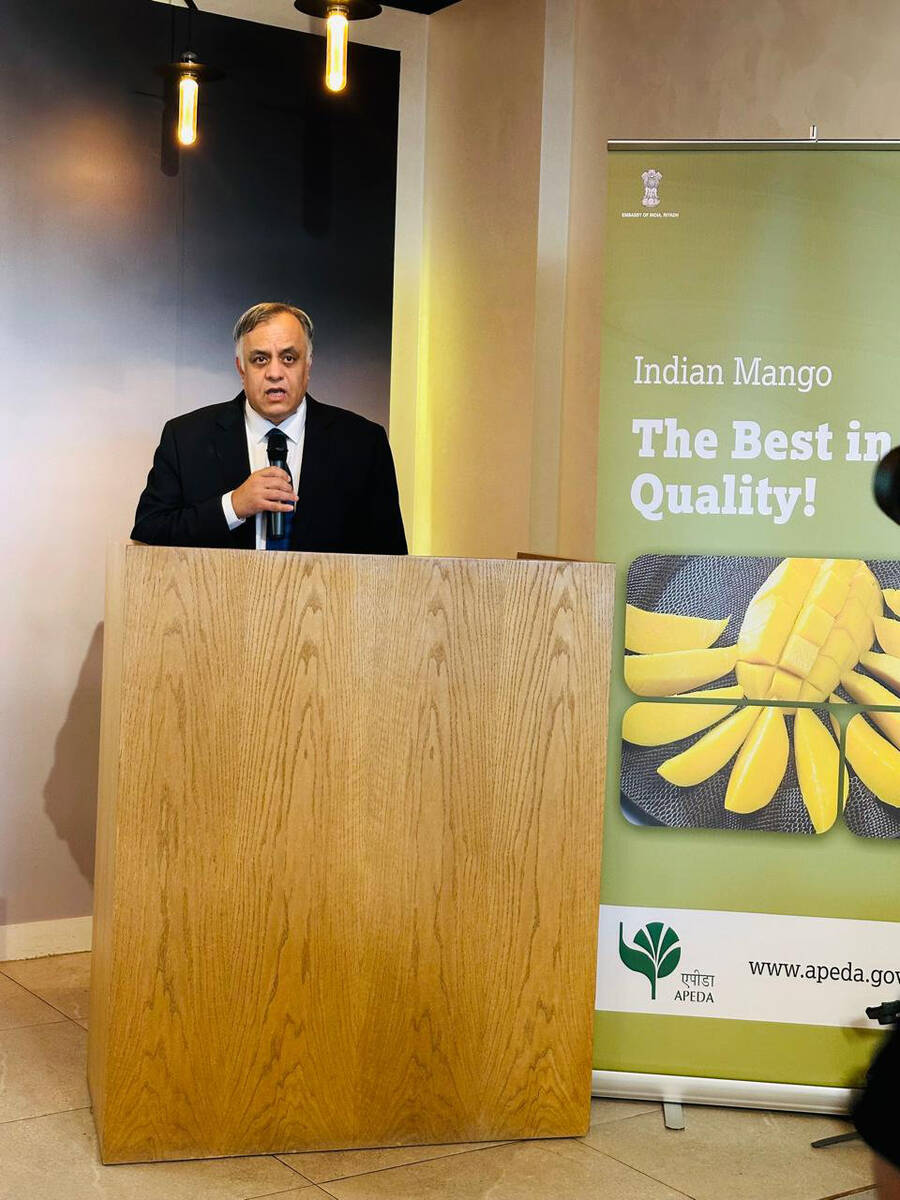
He said Saudi Arabia is a significant importer of the fruit, ensuring the availability of premium varieties for local consumers.
The menu featured an array of dishes, including mango butter chicken and Goan mango fish curry, blending Indian culinary traditions with Saudi ingredients such as dates and Madinah mint.
A standout feature of the event was the salad corner, which introduced a fusion of mangoes and millets, aligning with the UN designation of 2023 as the “International Year of Millets.” This innovative approach not only celebrated mangoes but also promoted gluten-free, nutritious grains.

India is the world’s largest producer of mangoes, boasting over 1,200 local varieties and accounting for 45 percent of global production. The event served as a platform to showcase various regional mango varieties, including the renowned Alphonso, as well as Geographical Indication-tagged options like Fazli and Rataul.
In conjunction with this event, a week-long Indian mango festival was launched at Lulu Hypermarket, further promoting the rich diversity of Indian mangoes to the Saudi market. APEDA representatives engaged in meetings with major Saudi retail chains to explore expanding the availability of these premium products.
London calling: Saudi cafés and restaurants find footing in UK capital

- A guide to finding a taste of home on your travels
LONDON: As the number of Saudi expats and visitors in London continues to grow, it’s no surprise that Saudi-owned brands are rising in popularity in the British capital. So, if you’re planning to make the big move — or just visiting — but you’re concerned about feeling homesick, don’t worry; your favorite cafés are coming with you, making your mornings abroad feel a little more like home.
Somewhere Café
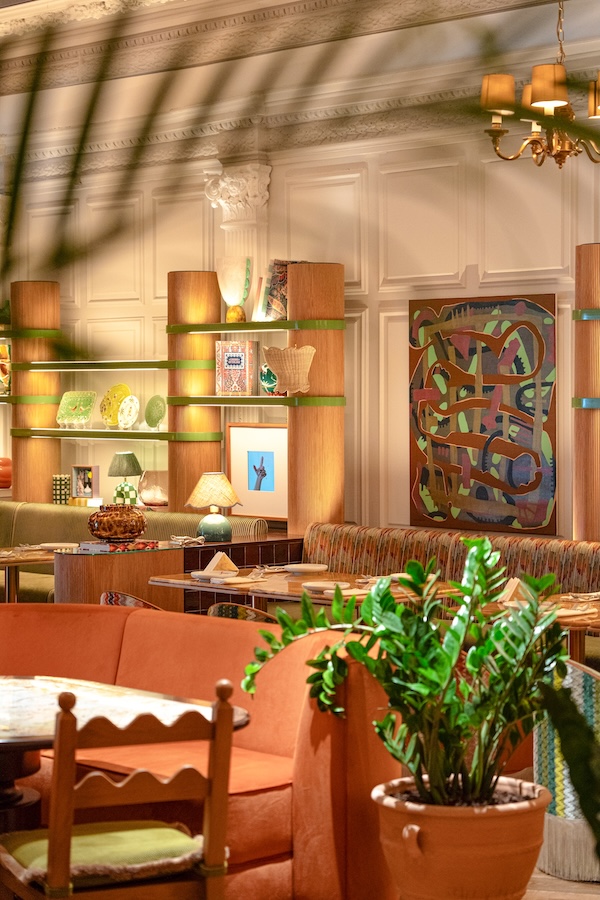
If you’ve visited Somewhere Café in the UAE or Saudi Arabia, then you’re already familiar with its unmatched ambiance, food, and décor. With its first UK outlet, the beloved café — which has joint Saudi-Emirati ownership — has brought its signature “home-away-from-home” experience, along with classic Middle Eastern flavors, to London’s premier department store: Harrods.
“Inspired by our travels, we invite you to experience a piece of our journey. Much like finding a painting and bringing it home as a memento, Somewhere celebrates the unique from everywhere. The space is elegantly well-travelled, with an eclectic touch, showcasing Middle Eastern influences through craft and curation,” co-founder Amal AlMarri told Arab News.
If you’re craving something beyond the ordinary, Somewhere Café delivers a fusion of flavors that reimagines nostalgic childhood dishes. Its most popular items include beef shawarma rice, kunafa croissant, and guacamole hummus. For lunch or dinner, you might try the crispy, golden shrimp kunafa or indulge in the rich truffle and cheese batata harra.
To complement its bold menu, the café features a warm, dimly lit interior — a cozy and inviting space to relax with friends and family. Before you leave, the dessert menu — featuring a delectable farak French toast or French coffee baklava — deserves an equal amount of attention.
Hijazi Corner

London’s first Saudi restaurant — Hijazi Corner — is a vibrant addition to the city’s dynamic culinary scene. At the helm is Chef Ayman Al-Zubaidi, who has cooked for Saudi royalty and celebrities. The inspiration behind the restaurant? His mother’s kitchen.
“When any chef starts to speak about food, they talk about their mum. Her chicken kabsa is a bit oily, a bit shiny, and looks amazing — even just talking about it now makes me hungry,” Al-Zubaidi told Arab News last year. “But even if I used the exact same ingredients and followed her method, hers would still taste better.”
Rooted in tradition, the menu features dishes typically found in Saudi homes — especially Jeddah’s historic Al-Balad district, where Al-Zubaidi grew up. Highlights include chicken seelag, slow-roasted lamb haneeth, and delicate, flaky samboosek.
In just two years, Hijazi Corner has become one of London’s most sought-after Middle Eastern restaurants — a testament to the deep longing among Saudi expats for authentic flavors from home.
Qahwah London

For those pining for the traditional, rich, aromatic flavors of Arabic coffee, Qahwah London is exactly what you need, with a wide selection of authentic qahwah options, including a tangy, spiced black coffee or the café’s signature Royal Infusion — a warming blend of cinnamon, cardamom, and ginger. Feeling hungry? Qahwah London also serves a range of traditional desserts such as baklava, kunafa, and basbousa — the perfect pairing for a steaming cup of Arabic coffee.
Guests can also book private gatherings for friends and family, or host intimate events like weddings or nikkah ceremonies. As part of its private offerings, the café provides a luxurious setting: rooms adorned with gold-plated coffee cups and an eye-catching assortment of traditional sweets — all designed to create a decadent group experience.
Diwan Kitchen

Diwan Kitchen is perfect for Saudis in the UK who are craving not only an authentic bite from home, but the feeling of being back in the Kingdom. It captures a key element of Arab culinary culture: its deeply social nature.
“We wanted to show people what traditional Saudi dining is like” Adem Nasraddin, co-founder of the restaurant, told Arab News on the restaurant’s opening night in May. “There’s a rhythm to Saudi life. A scent, a pace, a flavor. We bottled that feeling and served it on a plate.”
The menu takes diners on a journey across the Kingdom, from the Hijaz region, with its rich, tangy foul medammas — served in the center of the table with bread for sharing — to Najd, with jareesh, a hearty stew-like dish topped with fresh meat and vegetables.
Half Million

Grab a coffee and a quick bite at Half Million Café on Oxford Street, then stroll over to Hyde Park for the perfect London morning.
As in its original location in Saudi Arabia, Half Million in London is committed to delivering a “premium coffee experience.” Whether you’re in the mood for a classic breakfast tea or a vibrant red berry infusion, there’s something to satisfy every craving. And when the sun is out, their iced coffees offer the perfect refreshment. The menu — from cakes and sandwiches to freshly baked pastries — is completely halal.
If you’re after a bold, decadent brew in a sleek, stylish setting, Half Million Café is the ideal stop. With its modern cup designs and curated aesthetic, it’s a chic addition to London’s café scene.
What We Are Buying Today: ‘Lovera’ Saudi chocolate brand

Lovera is a Saudi chocolate brand with branches across the Kingdom and the GCC.
One day, while visiting a friend on short notice, I wanted to bring a gift that was both delicious and visually appealing. This is when I stumbled across Lovera on ToYou.
I chose the salted caramel bites, coated in fine Belgian chocolate and topped with crispy almonds.
The box contained three layers, about 35 pieces in total, and came in vibrant neon-orange packaging tied with a beautiful ribbon.
The chocolates were a hit; rich, smooth and perfectly balanced in flavor.
They offer a wide range of collections, including crunchy bites, truffles and seasonal assortments, but they may not suit all budgets as prices are on the higher end.
They also provide catering services for large events such as weddings, Eid gatherings and corporate parties. This includes options beyond chocolates, including tarts, eclairs, brownies and elegant finger canapes.
Lovera also has a cafe that serves a selection of cakes, hot and cold drinks, desserts, ice cream, mojitos and breakfast items. Their service can sometimes be slow and the items on the menu may not always be available.


